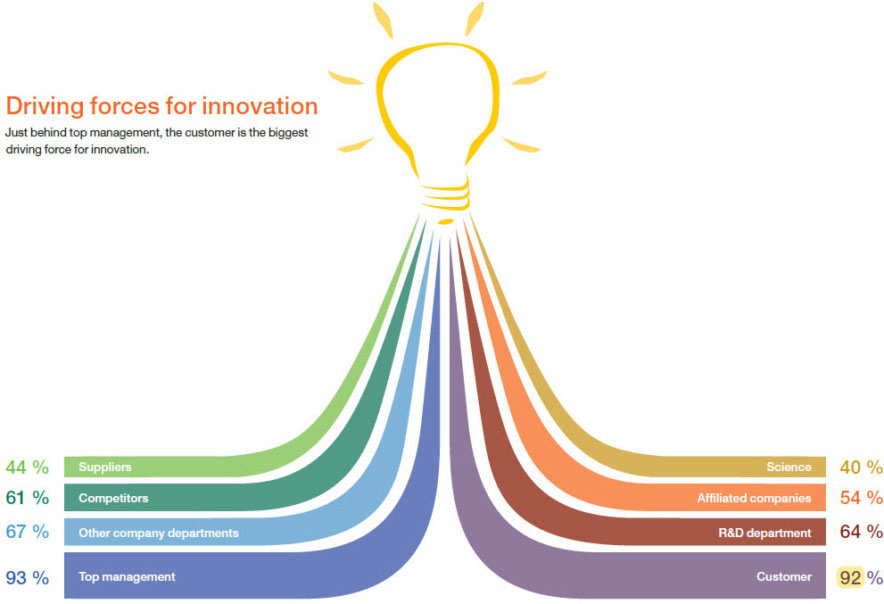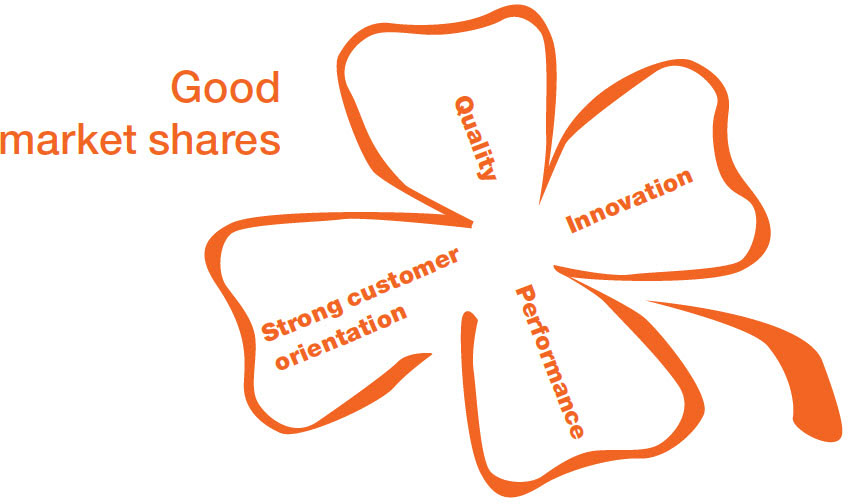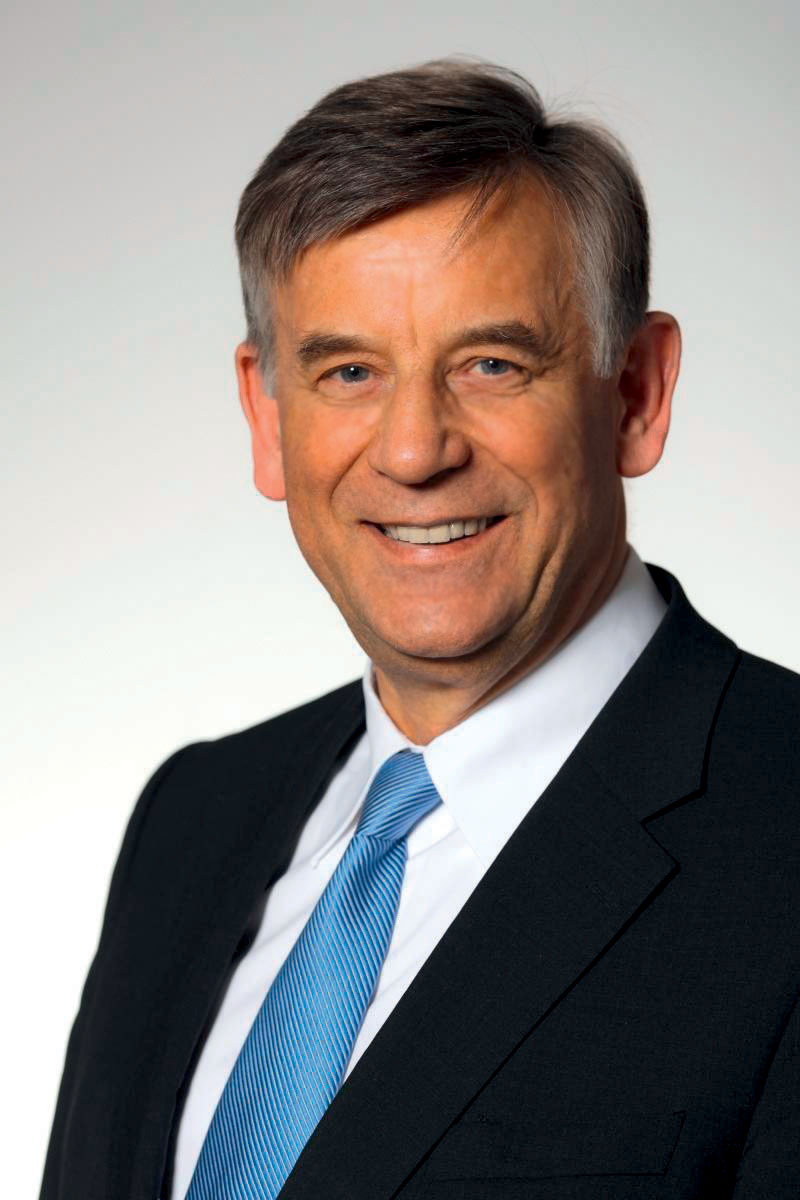
Particularly in the world of small and medium-size businesses, lasting success depends on a company’s innovative skill and speed. The celebrated business academic Hermann Simon has closely analysed the factors for the success of what he calls “Hidden Champions”.

Innovation is the key to world market leadership.
The steam engine, the Internet and the iPad – these are the kind of inventions that we commonly associate with the term “innovation”. Seemingly out of nothing, visionaries bring forth revolutionary new products that radically transform an existing market or create an entirely new one. However, this is not usually a true reflection of reality. If one looks closely at research and development departments, they are also hard at work on major breakthroughs. However, more likely to succeed, say experts like the Bonn business academic and innovation guru Prof. Hermann Simon, is a different strategy.
For more than two decades, Hermann Simon had been grappling with the issue of what makes unknown world market leaders, so-called Hidden Champions, what they are. For his most recent publication “Hidden Champions of the Twenty-First Century: The Success Strategies of Unknown World Market Leaders”, Simon has again investigated hundreds of barely known small and medium-size companies who in their market segment are among the world’s Top 3 and whose annual sales exceeded EUR 5 billion. Simon’s finding is that innovation is the key to world market leadership. There are a number of other factors for success – first and foremost, a strong focus, a strong customer orientation and an international outlook.
In terms of innovation, the Hidden Champions enjoy a lead over their competitors. Quite a number of them once founded their own markets with breakthrough innovations, e.g. Kärcher, the manufacturer of pressure washers, Flexi with its dog leads, and Brita with household water filters. But then staying on course for success is a different matter altogether: “The typical innovation process consists of minor improvements,” says Simon. Over a period of years and decades, products are refined and made cheaper and more customer-friendly in many tiny steps. Quite often, Simon concludes, market leadership is rooted in the fact that a company’s products are of exceptionally high technical quality after prolonged and continuous innovation. Competitors are unable to keep up. Companies improve not just their existing products, but also their processes and services.
The days when innovations were dreamed up in secluded laboratories where researchers turned the management’s ideas into reality are long gone. Although, Simon has found, the main impetus comes from top management, external influences are almost equally significant. The most important external factor, according to Simon, is the customer. In often close and trusting cooperation, new ideas are generated at the interfaces with the customer.

Source: “Hidden Champions of the Twenty-First Century: The Success Strategies of Unknown World Market Leaders”, Springer
In keeping with this is the fact that highly innovative companies often see themselves as market leaders, but define this broadly. A large proportion of them define market leadership not solely on the basis of sales or turnover, but also on technology and quality.
For innovation expert Simon, this is the right way to get the most economic mileage out of market leadership. Because the customer’s demands are challenging and geared less to low prices than to high quality and performance. From this, the Bonn business academic concludes that there are good and bad market shares. Bad market shares are those achieved with an aggressive pricing policy. They result in catastrophically narrow margins and may jeopardise the enterprise. Good market shares, on the other hand, are based on performance, quality, innovation and a strong customer orientation. The consequence is large margins, and profits can be ploughed back into strengthening the market position.
The most important external factor is the customer.
At Mitsubishi Electric, the research and development centres in Japan, North America, France and the United Kingdom also regularly bring forth new products and processes – most recently the tubular direct drive that ensures maximum precision and performance. Mitsubishi Electric also has the ability to transform new and changing customer needs into matching innovations. One mainstay in this endeavour in Germany is the Mainz Institute of Microtechnology (IMM), which has recently become part of the Fraunhofer Institute for Chemical Technology (ICT). With Mitsubishi Electric’s support, the engineers there have been devoting their attention to new technologies and applications for microproduction. Customers are closely involved in this and benefit from the fact that new products and processes are becoming increasingly precise and inexpensive. And this also with the aid of green technologies that Mitsubishi Electric has been developing since the 1960s – and thus decades before the subject shifted into the public eye. Today, all efforts to minimise resource consumption and reduce carbon emissions have been brought together in the Eco Changes programme.

Source: “Hidden Champions of the Twenty-First Century: The Success Strategies of Unknown World Market Leaders”, Springer
Incidentally, even supposed breakthrough innovations like the steam engine, the Internet or the iPad had their predecessors. What made the breakthrough were small but decisive improvements. So it may well be that the next big breakthrough innovation is already waiting in the wings for that all-important refinement.
Name of company:
Simon-Kucher & Partners
Founder:
Hermann Simon
The success of Hidden Champions rests on several pillars. The driving force is highly ambitious goals geared to global market leadership and growth. Hidden Champions have a strong focus, because only with focus can a company compete globally. At the same time, focus makes the market small. By globalising, Hidden Champions expand their market. All this is based on pronounced innovative powers and employees who are as highly skilled as they are motivated.
Breakthrough innovations are very rare. The vast majority of innovations consist of continuous improvements. The attention of the press and the general public, however, is focused almost exclusively on breakthrough innovations: consider the likes of Google, Facebook and 3D printing, for instance. Many of the Hidden Champions were catapulted to fame with breakthrough innovations, but have maintained their position with continuous improvement. Overall, there are many little things that make Hidden Champions better and that explain their strong market position. I believe that this is also the most important message for most companies. Of course, one always has to be on one’s guard in case a breakthrough innovation by the competition upsets the apple cart.
Together with globalisation, innovations are playing a decisive role in competition in China. And here one should consider not only products, but also process innovation. For instance, system integration, i.e. comprehensive solutions, and user-friendliness have grown strongly in importance in recent years. It is precisely in system integration, which calls for pronounced skill in dealing with complexity, that German companies excel. And we mustn’t forget the subject of globalisation in this context. The presence of Hidden Champions on the global markets today is much stronger than that of comparable Chinese companies. It takes years to build up such a global presence. So it certainly provides medium-term protection from new competitors from newly industrialised countries.
Prof. Dr. Dr. h.c. mult.
Simon-Kucher & Partners
Bestselling author and founder of global strategy consultants Simon-Kucher & Partners on innovation and global competition

Prof. Dr. Dr. h.c. mult. Hermann Simon
Fields marked with a * are mandatory.
Mitsubishi Electric Europe B.V.
German Branch
Mitsubishi-Electric-Platz 1
D - 40882 Ratingen
Sales
Tel.: +49 (0)2102 / 486 - 6120
edm.sales@meg.mee.com
Service
Tel.: +49 (0)2102 / 486 - 7600
edm.hotline@meg.mee.com
Applications
Tel.: +49 (0)2102 / 486 - 7700
edm.applikation@meg.mee.com
Spareparts
Tel.: +49 (0)2102 / 486 - 7500
edm.parts@meg.mee.com